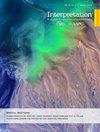Thermal evolution and hydrocarbon generation history of the Weibei uplift in the Ordos Basin
IF 1.1
4区 地球科学
Q3 GEOCHEMISTRY & GEOPHYSICS
Interpretation-A Journal of Subsurface Characterization
Pub Date : 2023-05-15
DOI:10.1190/int-2022-0073.1
引用次数: 0
Abstract
The Weibei uplift in the Ordos Basin has a distinctive tectonic setting and intricate evolutionary history. Along these lines, we have used the stratum temperature, apatite fission track, and vitrinite reflectance data to restore the thermal and hydrocarbon generation histories of the Weibei uplift. The average value of the present geothermal gradient of the Weibei uplift was 27.9°C/km, and the heat flow was 64.9 mW/m2. The Weibei uplift exhibited a moderate geothermal field. Three uplift cooling events occurred in the Weibei uplift during the Mesozoic era: the late Jurassic-early Cretaceous (162–125 Ma), the late Cretaceous (105–65 Ma), and the Eocene-Oligocene (40–27 Ma). The uplift history indicates an early uplift in the south region and a late uplift in the later stage. The thermal evolution history simulation demonstrates that the lower Palaeozoic Ordovician source rocks began to enter the hydrocarbon generation threshold in the middle Permian-late Permian (270 Ma) era and joined the hydrocarbon generation peak in the early-middle Jurassic event (180 Ma). The upper Palaeozoic Carboniferous-Permian source rocks began to enter the hydrocarbon generation threshold in the later period of the middle Permian period (235 Ma). They joined the hydrocarbon generation peak in the late Jurassic-early Cretaceous period (150 Ma). In addition, Triassic source rocks entered the hydrocarbon generation threshold in the early Cretaceous era (135 Ma) and did not enter the hydrocarbon generation peak until now. The low geothermal gradient of the Weibei uplift in the Palaeozoic-early Mesozoic reached the maximum paleotemperature in the early Mesozoic era (100 Ma) because of tectonic thermal events. The highest geothermal gradient of the early Cretaceous reached 51.5°C/km. The peak period of the hydrocarbon generation of source rocks of the different horizons in the Weibei uplift was regulated by the geothermal field of the early Cretaceous event. Since the late Cretaceous period, the stratum has been uplifted and cooled rapidly, and the hydrocarbon generation process of the source rocks has ceased.鄂尔多斯盆地渭北隆起热演化与生烃史
鄂尔多斯盆地渭北隆起具有独特的构造背景和复杂的演化历史。据此,我们利用地层温度、磷灰石裂变轨迹和镜质组反射率数据,恢复了渭北隆起的热生烃历史。渭北隆起目前的地热梯度平均值为27.9°C/km,热流为64.9mW/m2。渭北隆起为中等地热场。魏北隆起在中生代发生了三次隆升冷却事件:晚侏罗世-早白垩世(162–125 Ma)、晚白垩纪(105–65 Ma)和始新世-渐新世(40–27 Ma)。隆起历史表明,南部地区有早期隆起,后期有晚期隆起。热演化史模拟表明,下古生代奥陶系烃源岩在中石炭-二叠系(270Ma)开始进入生烃门限,早中侏罗世(180Ma)进入生烃高峰。上古生界石炭-二叠系烃源岩在二叠纪中期后期(235Ma)开始进入生烃门限。它们在晚侏罗世-早白垩世(150 Ma)加入了生烃高峰期。此外,三叠纪烃源岩在白垩纪早期(135Ma)进入生烃门限,直到现在才进入生烃高峰期。由于构造热事件的影响,卫北隆起在古生代中生代早期的低地热梯度在中生代早期达到了最高古温度(100Ma)。早白垩世最高地热梯度达到51.5°C/km,渭北隆起不同层位烃源岩的生烃高峰期受早白垩世事件地热场的调控。晚白垩世以来,地层迅速抬升和冷却,烃源岩的生烃过程停止。
本文章由计算机程序翻译,如有差异,请以英文原文为准。
求助全文
约1分钟内获得全文
求助全文
来源期刊

Interpretation-A Journal of Subsurface Characterization
GEOCHEMISTRY & GEOPHYSICS-
CiteScore
2.50
自引率
8.30%
发文量
126
期刊介绍:
***Jointly published by the American Association of Petroleum Geologists (AAPG) and the Society of Exploration Geophysicists (SEG)***
Interpretation is a new, peer-reviewed journal for advancing the practice of subsurface interpretation.
 求助内容:
求助内容: 应助结果提醒方式:
应助结果提醒方式:


